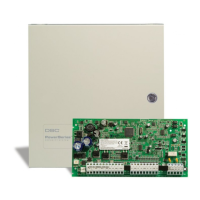9
Normally Closed Loops . . . . . . . . . . . . . . Section [013], Option [1]
Single End Of Line (EOL) Resistors
To enable panel detection of single end-of-line resistors, program
section [013], options [1] and [2] to OFF.
NOTE:
This option should be selected if either Normally Closed
(NC) or Normally Open (NO) detection devices or contacts are
being used.
The following chart shows zone status under certain conditions
for SEOL:
End of Line Resistors . . . . . . . . . . . . . . . . Section [013], Option [1]
Single End of Line Resistors . . . . . . . . . . . Section [013], Option [2]
Double End of Line (DEOL) Resistors
Double End of Line resistors allow the panel to determine if the
zone is in alarm, tampered or faulted.
To enable panel detection of double end of line resistors, program
section [013], option [1] to OFF and option [2] to ON.
NOTE:
If the Double EOL supervision option is enabled, all hard-
wired zones must be wired for Double EOL resistors, except for
Fire and 24 Hour Supervisory zones. Do not use DEOL resistors for
Fire zones or 24 Hour Supervisory zones.
NOTE: Do not wire Fire zones to keypad zone terminals if the
DEOL supervision option is selected.
NOTE: This option can only be selected if Normally Closed (NC)
detection devices or contacts are being used. Only one NC contact
can be connected to each zone.
The following chart shows zone status under certain conditions
for DEOL:
End-of-Line Resistors . . . . . . . . . . . . . . . . Section [013], Option [1]
Double End-of-Line Resistors . . . . . . . . . . Section [013], Option [2]
If the PC1616/PC1832/PC1864 is set up for Double
End of Line (DEOL) resistors the panel will detect both Fault and
Tamper (Short and Open) conditions as tamper condition. Keybus
fault and Zone Expander Supervisory will also be detected as
tamper conditions. When a tamper event occurs due to the
tamper switch activation on a wireless device, RF Zone Trouble
Supervisory Fault, or hardwired zones configured for Double End
Of Line supervision, the system will go into an alarm and tamper
condition. There is also a change in the [*][2] Trouble Display
where the meaning of light 5 changes from Zone Fault to RF
Supervisory Fault indication. Trouble light 6 - Trouble Zone
Tamper - will include Fire Zone trouble indication.
NOTE:
The system will not go into alarm when a tamper
condition occurs.
This operation affects the PGM activation. Below is a list of condi-
tions which are treated as tamper events and will activate theBell
Status Output, Programming Access Output and System Tamper
Output/System Tamper Output:
• All Hardwired Zone Fault conditions
• All Hardwired Tamper Conditions
• 2-wire smoke open condition
• Module Tampers
• Zone Expander Supervisory
• TLM Trouble
• Bell Circuit Trouble
• Bus Fault
•RF Jam
• General supervisory condition
• General Tamper Condition
•AML Faults
Fire Zone Wiring - 4-Wire Smoke Detectors
All zones defined as Fire (see section 5.2 ’Basic Programming’)
must be wired according to the following diagram:
For a complete description of how fire zones operate, see section
5.2 ’Basic Programming’sections [001]-[004] option 07 and 08.
NOTE:
Smoke detectors must be latching type. To reset smoke
detector, enter [*][7][2].
Compatible 4-Wire Smoke Detectors
Fire Zone Wiring - 2-wire Smoke Detectors
If PGM 2 has been programmed for 2-Wire Smoke Detector con-
nection (see section 5.2 ’Basic Programming’), the detectors must
be wired according to the following diagram:
NOTE:
The maximum number of smoke detectors on the 2-wire
loop is 18.
Refer to the ‘2-Wire Smoke Detector Initiating Circuit’ table below.
For a complete description of how fire zones operate, see section
5.2 ’Basic Programming’section [009] option 04.
NOTE:
Do not combine models from different manufacturers on
the same circuit. Operation may be impaired.
Loop Resistance Loop Status
0Ω (shorted wire, loop shorted) Violated
5600Ω (contact closed) Secure
Infinite (broken wire, loop open) Violated
Loop Resistance Loop Status
0Ω (shorted wire, loop shorted) Fault
5600Ω (contact closed) Secure
Infinite (broken wire, loop open) Tamper
11200Ω (contact open) Violated
FRA
IMQ
Model Model Model
FSA-410x FSA-410xLST FSA-410xRST
FSA-410xT FSA-410xR FSA-410xLRST
FSA-410xS FSA-410xRT
FSA-410xST FSA-410xRS
For model numbers above: x=A (ULC) x=B (UL) x=C (CE)
10-30V
DC
To alarm
initiating
circuit
NO C NC
Panel
EOLR
RM-2
1 PGM 2
COM
+ AUX -
V+
V
-
ZONE
Additional 2-wire smoke detectors must be
connected in parallel as shown above.

